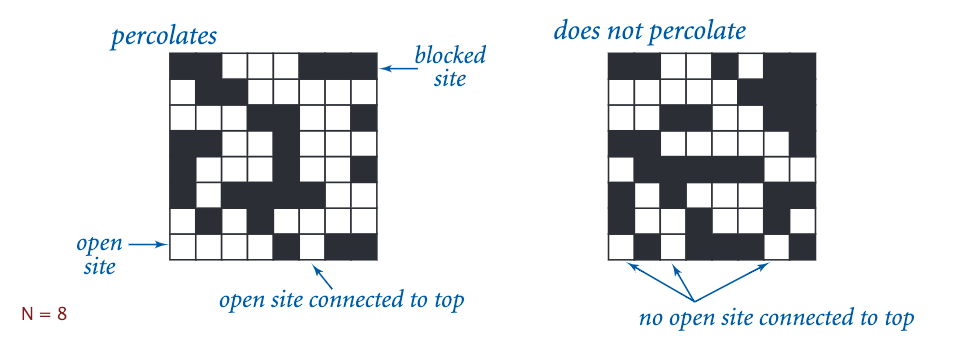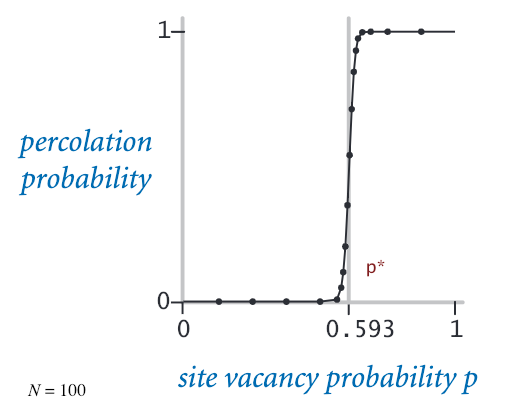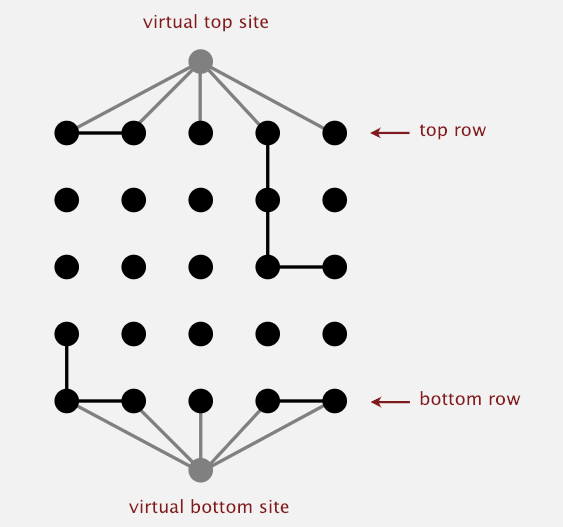📗【算法】Princeton 算法课程 ① 并查集
问题
Programming Assignment 1 是一个并查集的应用——渗透模型。

给定义一个 \(n\times n\) 的矩阵(代表一个系统),黑色代表节点被堵住,白色代表节点已经打开。默认情况下所有节点都被堵住,如果某一个节点与第一行的节点相连(connected),那么它就是 full 的。如果最后一行任意一个节点与第一个行任意一个节点相连,那么整个系统就是 percolation。
假设每个节点打开的概率是 \(p\),求整个系统 percolation 的阀值估计。

对于这个问题,我们可以使用 蒙特卡洛模拟(Monte Carlo simulation):
- 所有的节点初始化为关闭(blocked)
- 重复以下步骤,直到系统实现 percolation
- 在所有关闭的节点中随便选择一个
- 打开(open)这个节点
- 此时打开的节点个数/总节点个数就是系统的阀值
假设经过 \(T\) 次实验,每次实验的阀值是 \(x_t\),则平均值 \(\bar x\) 和方差 \(s^2\) 的计算公式如下:
\[\bar x=\frac{x_1+x_2+\dots+x_T}{T}, s^2=\frac{(x_1-\bar x)^2+(x_2-\bar x)^2+\dots+(x_T-\bar x)^2}{T-1}\]假设 \(T\) 足够大,下面给出阀值估计的 \(95\%\) 的置信区间:
\[\Bigg[ \bar x-\frac{1.96s}{\sqrt{T}}, x+\frac{1.96s}{\sqrt{T}} \Bigg]\]要求实现两个类。Percolation.java 使用给定的 WeightedQuickUnionUF 实现以下 API,用于对渗透模型进行操作。
public class Percolation {
public Percolation(int n) // create n-by-n grid, with all sites blocked
public void open(int row, int col) // open site (row, col) if it is not open already
public boolean isOpen(int row, int col) // is site (row, col) open?
public boolean isFull(int row, int col) // is site (row, col) full?
public int numberOfOpenSites() // number of open sites
public boolean percolates() // does the system percolate?
public static void main(String[] args) // test client (optional)
}
PercolationStas.java 使用设计好的 Percolation 类进行蒙特卡洛模拟,并计算平均值、方差、置信区间等。
public class PercolationStats {
public PercolationStats(int n, int trials) // perform trials independent experiments on an n-by-n grid
public double mean() // sample mean of percolation threshold
public double stddev() // sample standard deviation of percolation threshold
public double confidenceLo() // low endpoint of 95% confidence interval
public double confidenceHi() // high endpoint of 95% confidence interval
public static void main(String[] args) // test client (described below)
}
思路
Robert Sedgewick 已经在 Lecture Slides 上提到了一种有效的解决方案,那就是构造虚拟两个节点,以判断整个系统是否是 percolation。

这种方式相当高效,我之前想的一种方法就无奈超时,这样 isFull() 和 percolation() 方法都是常数时间复杂度,这要比遍历一行节点效率高得多,尤其是第二个类的运行时,遍历的方法大概两分钟才能跑出来结果,而虚拟节点只需要两三秒钟。
不过虚拟节点会出现 回流 问题,可以内置两个 WeightedQuickUnionUF 对象,分别用于 isFull() 和 percolation() 两种方法的记录。
实现
好不容易冲到了 99,需要用 FindBugs 和 CheckStyle 保证代码质量。
有时间把需要注意的地方补充了。
- 版权声明:本文采用知识共享 3.0 许可证 (保持署名-自由转载-非商用-非衍生)
- 发表于 2019-03-24